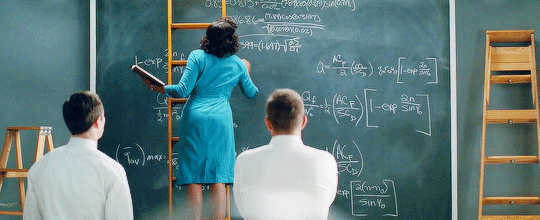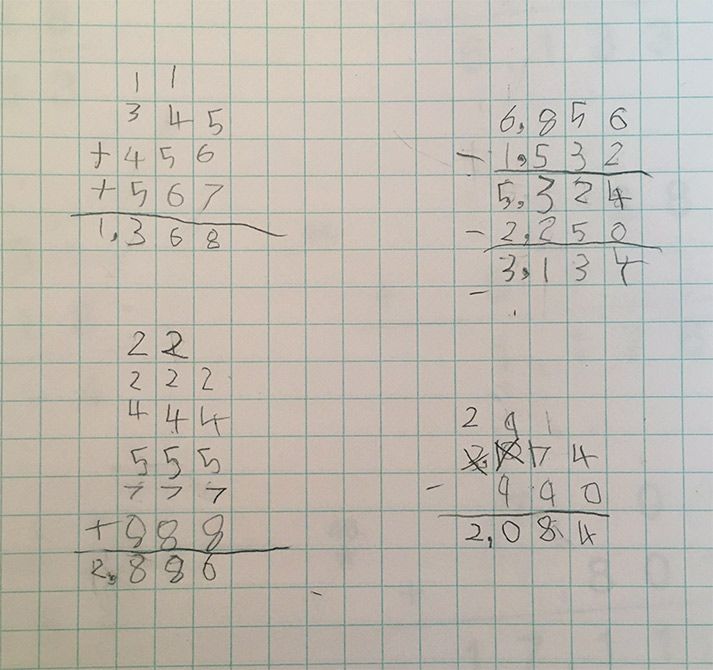Why is it so hard for kids to show their work?
We've made a lot of progress on writing out math problems, so I thought I'd share some of what I've figured out along the way.

I'm guessing this is a fairly universal challenge: getting kids to JUST. WRITE. THE. DAMNED. PROBLEM. DOWN. We've made a lot of progress on this, so I thought I'd share some of what I've figured out along the way.
Want the tl;dr version? Buy a small whiteboard with grid lines, and a pack of ultra fine dry erase markers. Be patient, it's harder than you remember. You're welcome.
Read on if you want the nitty gritty:
(A bit of context: Beast Academy is our math curriculum. My daughter is currently 8yo, she's gifted, and has ADHD. She's doing math work a couple years ahead of where most kids her age are, so we've got some asynchrony happening here.)
The writing-math-out skills
First, let's talk for a moment about some of the skills that go into writing out math problems, skills you and I developed so long ago that we don't think about them:
- writing legibly
- lining up place value digits
- learning how big or small to write the numbers
- learning to write the correct equation syntax
- learning algorithm-specific actions, e.g., crossing out a digit when you break it during subtraction and writing the new place value
- figuring out when to reach for your pencil vs. when to do it in your head
- learning how much to erase when something isn't working
- figuring out when to give up on one strategy and try switching to another approach
There's a lot going on! Those skills are a bit meta: they're happening parallel to the specific math concepts that she's also learning about. Some are mechanical skills, and will take practice. Others are judgement skills, and will take experimentation.
Let's think about it in practice: when she's first learning about the concepts of area and perimeter, and how to do the math to measure them, is she going to want to also work on these writing-it-down skills when she's doing the calculations? Not likely! Her instinct may be that it's too much unfamiliar stuff at once, and she'll feel a strong urge to try to do it in her head. After all, it's just simple adding or multiplying, she's done that plenty of times! That's understandable. Annnnnd then she'll biff some bit of arithmetic, and get it wrong. She won't immediately see how writing it down could have helped, especially in the moment when she may be heated at herself for goofing up something she's already supposed to know how to do. And then you'll say "this is why you need to write it down!" and she will not thank you, she will want to chuck you off the nearest pier! Sound familiar?
I've learned to be patient as she develops these less-obvious writing-math-out skills. It's not as simple as it seems.
I've found several angles to helping her develop these skills:
- Normalize writing out the math
- Help her see the value in it
- Make it easier and more appealing
- Give her some stepping stones to get there
Normalizing it, and seeing the value in it
One of the early things I did was help her see that real-life, high-level mathematicians write out their work. I explained that they do it for a few reasons:
- To free up their brain to think about the really interesting parts of the problem
- To minimize the risk of mistakes
- To communicate with colleagues:
- So they all have the same information
- So they can see how you came to your conclusions
- So that if there's an error, it can be spotted

We watched the movie Hidden Figures which illustrated these points beautifully and gave her a wonderful mathematician to look up to in Katherine Johnson. I'll sometimes say to her, "Don't accidentally launch astronauts into deep space!" as a silly way to point out that we care about accuracy in math.

To help her develop the communication aspect of the skill, I leaned on our old friend Tom the Dog. This earlier post about Tom gives more info, but in short, he's a stuffed animal who needs help understanding math, and Wanda explains things to him. That doesn't directly get her doing any writing, but it helps her organize her thinking, which seems a helpful thing to do, and it normalized this sort of sharing and communicating.
With time, I was able to gently guide her through some post-mortems to identify the kinds of mistakes she was making in her math. She was eventually able to see that very often it had nothing to do with her understanding of the concept being taught, but was instead because of a really simple arithmetic error (a common frustration for ADHD folks). Through discussion, I was able to gently nudge her to the idea that writing more of the problems down could make a difference.
Making it easier and more appealing
Graph paper helps a ton with lining up the numbers, and makes it easier to learn to write legibly. It helps to organize the work, and keeps the numbers nice and small.

That didn't do the trick, though. When you're new to writing, it doesn't feel ephemeral yet, so tossing dead-end work aside and starting over with a fresh piece of paper doesn't necessarily feel right and good. It was an ah ha! moment for me when I realized that some of the resistance to writing her problems down wasn't so much about the writing, it was about the erasing. Easy erasing gives you freedom to experiment, and experimenting helps you figure out what works and what doesn't.

Enter the whiteboard! It's much easier to let your writing be ephemeral on a whiteboard. The erasing is so easy! But with no grid lines, and chunky dry erase markers, it's kind of a disorganized mess.

The solution! A small, grid-lined whiteboard, and a set of ultra fine tip dry erase markers. Don't underestimate the power of colorful markers. Wanda says that colors help her stay engaged, and sometimes she color-codes to organize her work.

Giving her stepping stones to get there
Sometimes she will freeze up when trying to identify where to start with writing a problem down. We've found that she sometimes has an easier time when she is standing up at the big whiteboard, so we do the work there. ADHD folks often have an easier time fully engaging when their whole body gets to be in motion. (Dry erase markers also work on windows, that can be a fun way to mix it up.)
At times, I've provided a bit of scaffolding: I'll take on one aspect of writing the problem down, so she can get practice developing another aspect. For example, she figures out what needs to be written, and I write it (thus modeling the syntax for her to do next time), or I figure out what needs to be written (thinking out loud, to model that skill), and she gets practice with writing. If she gets in the weeds with a new algorithm, and she's open to my coaching, I'll verbally cue her on syntax and actions.
And eventually...
After a lot of patience and practice, the pieces started to finally come together enough for her to start to recognize the benefit of writing her work down. It got easier, it got faster, and she was able to see that she made fewer mistakes, which in turn has made her more likely to reach for a pen. You're welcome, future astronauts!

